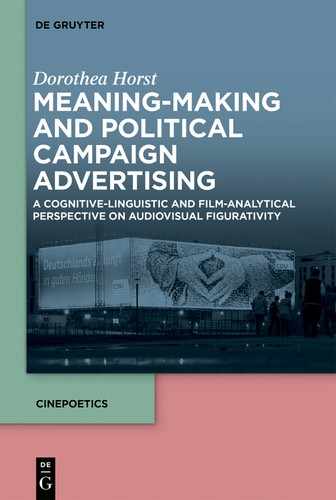0%
24Chapters
0-1Hours read
0kTotal Words
Table of Contents
- Cover
- Title Page
- Copyright
- Acknowledgements
- Contents
- 1 Introduction
- 2 The State of Research on Campaign Commercials and Figurativity
- 3 Cognitive-Linguistic Perspectives on Figurativity
- 4 Film-Theoretical Perspectives on Figurativity
- 4.1 Figuration and Illocution: Figurativity and the Film Code
- 4.2 Artistry and Cognitive Principle: Figurativity and Message Deciphering
- 4.3 Intellectual Shock and Affective Fusion: Figurativity and Viewers’ Participation
- 4.4 Double Vision and Cinematic Expressivity: Figurativity and Embodied Experience
- 4.5 Conclusion
- 5 Implications of a Dynamic Approach to Audiovisual Figurativity
- 6 Angela Merkel, a Sovereign With Civil Roots
- 6.1 The Image of a Monarch: Angela Merkel as Political Message
- 6.2 ‘I Am You’: Angela Merkel as Representative of the German People
- 6.3 The Experience of Gravitas: Angela Merkel as Center of Power
- 6.4 “We Have the Power”: Angela Merkel and a Sense of Commonality
- 6.5 Conclusion: Metaphor and Metonymy as Interrelated Meaning-Making Processes
- 7 Donald Tusk, a Leading Builder Under Pressure
- 7.1 Highlighting an Ongoing Process: “Poland Under Construction”
- 7.2 An Unfolding Construction Scenario: Donald Tusk as Leading Builder of a Future Poland
- 7.3 Feeling the Workload: Donald Tusk as Being Overwhelmed with Duties
- 7.4 The Pressure of Premiership: Donald Tusk and a Message of Apology
- 7.5 Conclusion: The Interplay of Language and Audiovisual Staging as Rhetorical Design
- 8 Jarosław Kaczyński and Frank-Walter Steinmeier: A Door Opener and a Sober Problem Solution
- 8.1 Two Challengers, Different Foci: Self-Promotion as Opposition and as Governing Party
- 8.2 Jarosław Kaczyński: Opening Doors and Conquering Hindrances
- 8.3 Frank-Walter Steinmeier: Giving a Realistic Answer to Existential Questions
- 8.4 Similarities and Differences Among Challenger and Incumbent Images
- 8.5 Conclusion: The Intertwining of Language and Audiovisual Staging as Qualitative Criterion
- 9 Conclusion and Prospects
- Bibliography
- Audiovisual Sources
- List of Figures
- Name Index
- Subject Index
